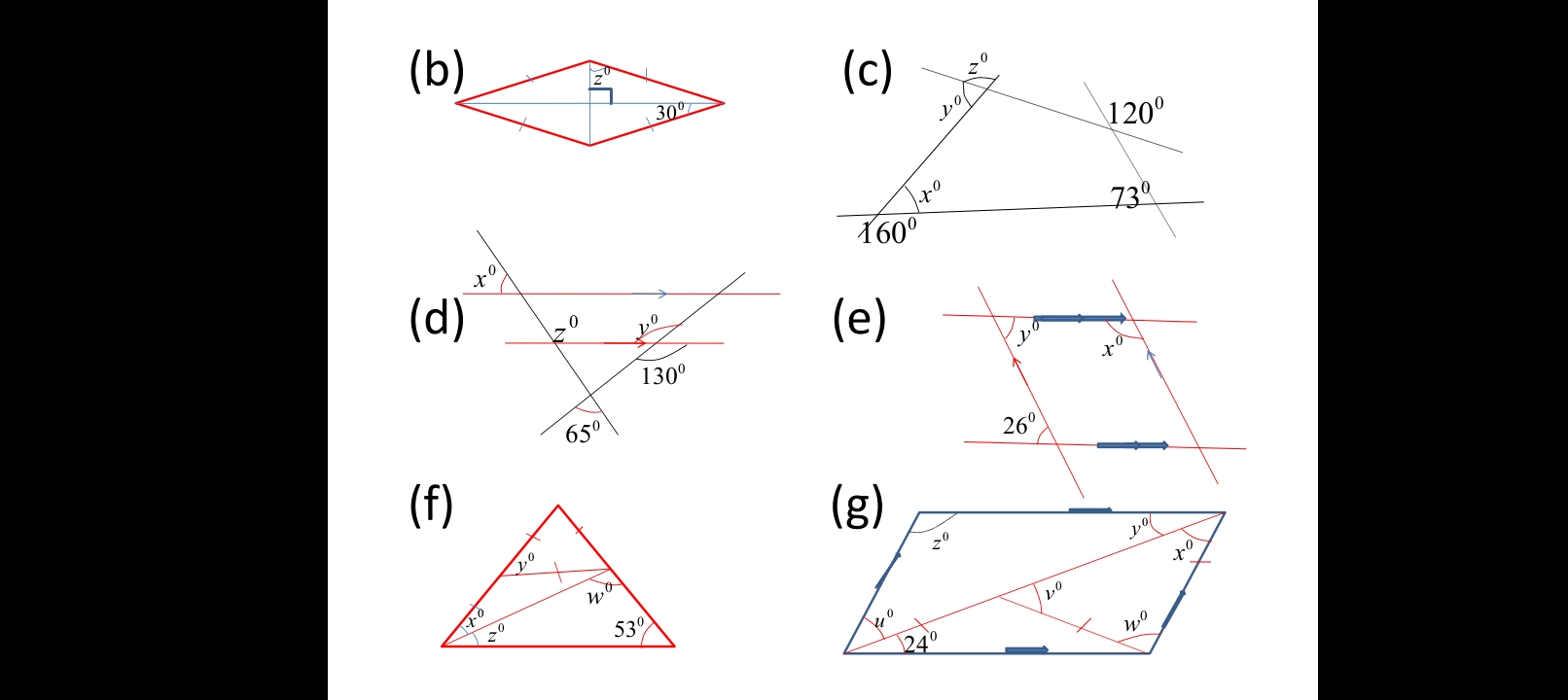Calculate the values of x°, y°, z°, and w° in the provided geometric figures.

Understand the Problem
The question seeks to solve for the unknown angles labeled as x°, y°, z°, and w° in various geometric figures. This involves applying geometric principles such as the properties of angles, parallel lines, and triangles.
Answer
The angles are: $z^\circ = 30^\circ$, $v^\circ = 60^\circ$, $x^\circ = 60^\circ$, $y^\circ = 50^\circ$, $x^\circ = 77^\circ$, $w^\circ = 50^\circ$, $y^\circ = 26^\circ$, $w^\circ = 77^\circ$, and $y^\circ = 154^\circ$.
Answer for screen readers
The angles are:
- $z^\circ = 30^\circ$
- $v^\circ = 60^\circ$
- $x^\circ = 60^\circ$
- $y^\circ = 50^\circ$
- $x^\circ = 77^\circ$ (in triangle f)
- $w^\circ = 50^\circ$
- $y^\circ = 26^\circ$ (in e)
- $w^\circ = 77^\circ$ (in f)
- $y^\circ = 154^\circ$ (in e)
Steps to Solve
- Calculate angle $z^\circ$ in (b)
In a parallelogram, opposite angles are equal. Thus,
[ z^\circ = 30^\circ ]
- Find angle $v^\circ$ in (c)
Using the fact that the sum of angles on a straight line is $180^\circ$, we have:
[ v^\circ + 120^\circ = 180^\circ \implies v^\circ = 60^\circ ]
- Determine angle $x^\circ$ in (c)
Since alternate interior angles are equal,
[ x^\circ = 60^\circ ]
- Calculate angle $y^\circ$ in (d)
The angles $y^\circ$ and $130^\circ$ are supplementary:
[ y^\circ + 130^\circ = 180^\circ \implies y^\circ = 50^\circ ]
- Find angle $x^\circ$ in (f)
Using the triangle sum theorem (the sum of angles in a triangle is $180^\circ$):
[ x^\circ + y^\circ + z^\circ = 180^\circ \implies x^\circ + 50^\circ + 53^\circ = 180^\circ ] [ x^\circ = 77^\circ ]
- Calculate angle $w^\circ$ in (f)
Using triangle sum theorem again:
[ w^\circ + 50^\circ + 53^\circ = 180^\circ \implies w^\circ = 77^\circ ]
- Find angle $w^\circ$ in (g)
Using properties of angles in a quadrilateral:
[ w^\circ + x^\circ + y^\circ + z^\circ = 360^\circ ] Substituting known angles:
[ w^\circ + 77^\circ + 50^\circ + 24^\circ = 360^\circ \implies w^\circ = 209^\circ ]
- Determine angle $y^\circ$ in (e)
Using the properties of parallel lines:
[ y^\circ = 26^\circ ]
- Calculate angle $v^\circ$ in (e)
Using the opposite angles theorem:
[ v^\circ = 154^\circ ]
The angles are:
- $z^\circ = 30^\circ$
- $v^\circ = 60^\circ$
- $x^\circ = 60^\circ$
- $y^\circ = 50^\circ$
- $x^\circ = 77^\circ$ (in triangle f)
- $w^\circ = 50^\circ$
- $y^\circ = 26^\circ$ (in e)
- $w^\circ = 77^\circ$ (in f)
- $y^\circ = 154^\circ$ (in e)
More Information
These angles are derived using properties of angles in parallelograms, triangles, and relationships involving parallel lines and transversal segments.
Tips
- Confusing alternate interior angles with corresponding angles.
- Forgetting that the sum of angles in a triangle must equal $180^\circ$.
- Miscalculating supplementary angles (the sum must be $180^\circ$).
AI-generated content may contain errors. Please verify critical information